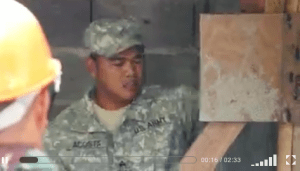 (Chemical biological radiological nuclear & high-yield Explosive Enhanced Response Force Package) team has traveled to Subic Bay, Philippines to teach fifty local first responders, from the Philippine Armed Forces, Philippine Red Cross, and the Subic Bay Metropolitan Authority about urban search and rescue from 9 to 14 September.
(Chemical biological radiological nuclear & high-yield Explosive Enhanced Response Force Package) team has traveled to Subic Bay, Philippines to teach fifty local first responders, from the Philippine Armed Forces, Philippine Red Cross, and the Subic Bay Metropolitan Authority about urban search and rescue from 9 to 14 September.
The Hawaii team coordinated with local search and rescue leaders to hold the five-day course. Instructors taught two parallel courses of rope rescue with patient packaging, and collapsed structure shoring. A bonus class of rescue site marking was added on day three and four.
The Rope rescue course started with basic knot tying and progressed through pulley systems ending with rescue rappelling. SSG Cory Ito with the CERF-P Team said “By the end of today (the second) they will be able pick up patients and raise and lower them in a STOKES basket”.
Collapsed structure shoring started with the issuing of the army corps of engineers rescue playbook, which contains FEMA derived plans, and progressed through wood working basics ending with the construction of various shoring systems.
“Shoring up a damaged building insures you have a safe amount of time to enter the structure to rescue the casualties”, said Sgt Rodolfo Acosta with the CERF-P team lead shoring instructor. “An experienced team can build a shoring system in about ten minutes, using the wood and materials found on scene.”
The Hawaii National Guard brings all of the latest equipment from ropes and harnesses to rescue cameras. Most of the students are seeing this equipment for the first time. The local officers often make purchasing plans for their equipment based off the gear they see at the training. The final day of instruction consisted of a mini exercise where the teams where tested in a scenario based exam.
Instructors used a “hands on” approach to help overcome the language barrier. Native language speaking guardsmen and facilities from the local forces also helped bridge the gap. The experience level of the students ranged from novice getting their first taste of theses rescue techniques to experts looking to expand their skill sets.
The event the first of three to beheld in the next twelve months is a part of the initial site survey for Balikatan, aiming develop the urban search and rescue in the local forces. The Philippines is a country that experiences many different kind of natural disasters due to it geographic location. The teams leave with an increased working knowledge of rescue techniques and stronger relationships and camaraderie.

